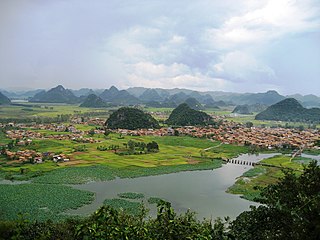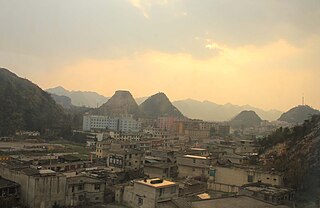Related Research Articles

The Gelao people are an ethnic group of China and Vietnam. They form one of the 56 ethnic groups officially recognized by the People's Republic of China. However, many Gelao are also variously classified as Yi, Miao, and Zhuang by the Chinese government.
The Hmu language, also known as Qiandong Miao, Central Miao (中部苗语), East Hmongic, or Black Miao, is a dialect cluster of Hmongic languages of China. The best studied dialect is that of Yǎnghāo (养蒿) village, Taijiang County, Guizhou Province.
Gelao is a Kra language in the Kra–Dai language family. It is spoken by the Gelao people in southern China and northern Vietnam. Despite an ethnic population of 580,000, only a few thousand still speak Gelao in China. Estimates run from 3,000 in China by Li in 1999, of which 500 are monolinguals, to 7,900 by Edmondson in 2008. Edmondson (2002) estimates that the three Gelao varieties of Vietnam have only about 350 speakers altogether.
The Kam or Gam language, also known as Dong, is a Kam–Sui language spoken by the Dong people. Ethnologue distinguishes three Kam varieties as separate but closely related languages.

Bijie is a prefecture-level city in northwestern Guizhou Province, China, bordering Sichuan to the north and Yunnan to the west.

Funing County is located in Wenshan Zhuang and Miao Autonomous Prefecture, in the east of Yunnan province, China. It is the easternmost county-level division of Yunnan, bordering Guangxi to the north, east and southeast, and Vietnam's Hà Giang Province to the south.

Qiubei County is under the administration of the Wenshan Zhuang and Miao Autonomous Prefecture, in southeast Yunnan province, China.

Liuzhi Special District is a district of Guizhou, China. It was known as Langdai Country before 1960. The county is under the administration of Liupanshui city, located in the western part of Guizhou Province. It is bounded by Zhijing and Nayong to the north, Guanling to the south, Zhenning and Puding to the east, Shuichen to the west, as well as Qinglong and Pu'an to the southwest. The area is approximately 1,792 km2 (692 sq mi). The population is 729,000. There are about 32 ethnic minorities and they account for 30.52% of the population.
The Then language is a Kam–Sui language spoken in Pingtang and Huishui counties, southern Guizhou. It is spoken by the Yanghuang 佯僙 people, many of whom are officially classified as Maonan by the Chinese government.
The West Hmongic languages, also known as Chuanqiandian Miao and Western Miao, are a major branch of the Hmongic languages of China and Southeast Asia.
Cao Miao is a variety of Dong (Kam) according to Shi Lin (2012). Dialects include Liushi ("Sixty") Miao 六十苗, Sishi ("Forty") Miao 四十苗, and Ershi ("Twenty") Miao 二十苗. The Flowery Miao 花苗 do not consider themselves to be Cao Miao 草苗, although their language is similar to Sixty Miao and Forty Miao.
Caijia is an endangered Sino-Tibetan language spoken in an area centred on Bijie, in the west of the Chinese province of Guizhou. It was first documented by Chinese researchers in the 1980s. It has been described by different authors as a relative of Bai or an early split from Old Chinese. The autonym is. According to Lu (2022), Caijia speakers in Xingfa 兴发乡, Hezhang County refer to their language as.

The Qixingmin are an officially unrecognized ethnic group of western Guizhou province, China. They are officially classified as Bai by the Chinese government. The Qixingmin speak a Yi (Loloish) language known as Luoji. The Guizhou Province Ethnic Gazeteer (2002:692) reports that, in 1982, there were about 700 speakers among the more easterly Qixingmin.

The Longjia are an unofficially recognized ethnic group of western Guizhou province, China. They are officially classified as Bai by the Chinese government.
The Greater Bai or simply Bai languages are a putative group of Sino-Tibetan languages proposed by Zhengzhang, a linguist, in 2010, who argues that Bai and Caijia are sister languages. In contrast, Sagart (2011) argues that Caijia and the Waxiang language of northwestern Hunan constitute an early split off from Old Chinese. Additionally, Longjia and Luren are two extinct languages of western Guizhou closely related to Caijia.
Longjia is a Sino-Tibetan language of Guizhou, China related to Caijia and Luren. Longjia may already be extinct.
Lu, or Luren (卢人), is an extinct Sino-Tibetan language of Guizhou, China. The Luren language may have been extinct since the 1960s.
Xiqi is an unclassified Loloish language of Huaning County, Yunnan, China. It is also called Siqipo 斯期颇 in Mile County.
References
- ↑ "China". Asia Harvest. Archived from the original on 2013-08-01. Retrieved 2013-07-19.
- ↑ "贵州省民族事务委员会-贵州省民族识别认定工作". Gzmw.gov.cn. Archived from the original on 2012-08-02. Retrieved 2013-07-19.
- ↑ Wang Xianjun [王献军] (2011). 贵州“里民人”探寻.
- ↑ Hou Jingrong . 2009. Phonological System and Linguistic Typology of Liujia Chinese Dialect in Sanjiang of Guangxi Autonomous Region [广西三江县六甲话的语言特点]. http://comonca.org.cn/PDF/2009/COMONCA03-010.pdf%5B%5D
- ↑ Ai, Lan 艾兰. 2020. Sanjiang Liujiahua yanjiu 三江六甲话研究. Changchun: Jilin wenshi chubanshe 吉林文史出版社.
- ↑ Guizhou Province Gazetteer: Ethnic Gazetteer [贵州省志. 民族志] (2002). Guiyang: Guizhou Ethnic Publishing House [貴州民族出版社].
- ↑ Qianxi County Gazetteer (1990:157)
- ↑ "白族家园-讲义寨". 222.210.17.136. 2011-01-28. Archived from the original on 2014-10-17. Retrieved 2013-07-19.
- ↑ 贵州"六山六水"民族调查资料选编. 回族, 白族, 瑤族, 壮族, 畲族, 毛南族, 仫佬族, 满族, 羌族卷 (2008). 贵州民族出版社.
- ↑ Liupanshui City Ethnic Gazetteer 六盘水市志:民族志 (2003:186-187). ISBN 7-221-05533-5
- ↑ Xixiu District Gazetteer 安顺市志:西秀区志 (2007:110)
- ↑ You Weiqiong [尤伟琼]. 2013. Classifying ethnic groups of Yunnan [云南民族识别研究]. Beijing: Ethnic Publishing House [民族出版社].
- ↑ "安顺市天龙镇屯堡方言声韵调系统初探". Archived from the original on 2017-12-04. Retrieved 2017-12-04.
- ↑ Long Yiteng, Wu Weijun, Song Yi, Ming Shengrong [龙异腾, 吴伟军, 宋宜, 明生荣]. 2011. A study of the Tunbao dialect of Central Guizhou [黔中屯堡方言研究]. Chengdu: Southwest Jiaotong University Press [西南交通大学出版社].